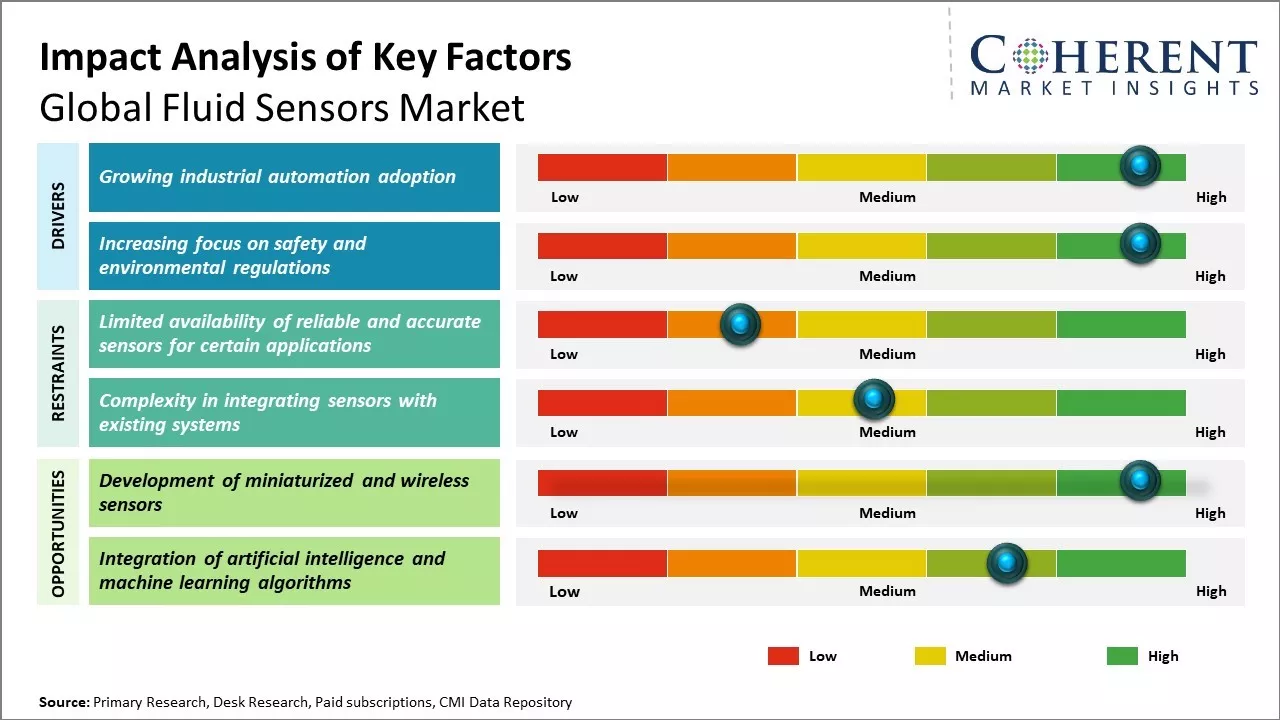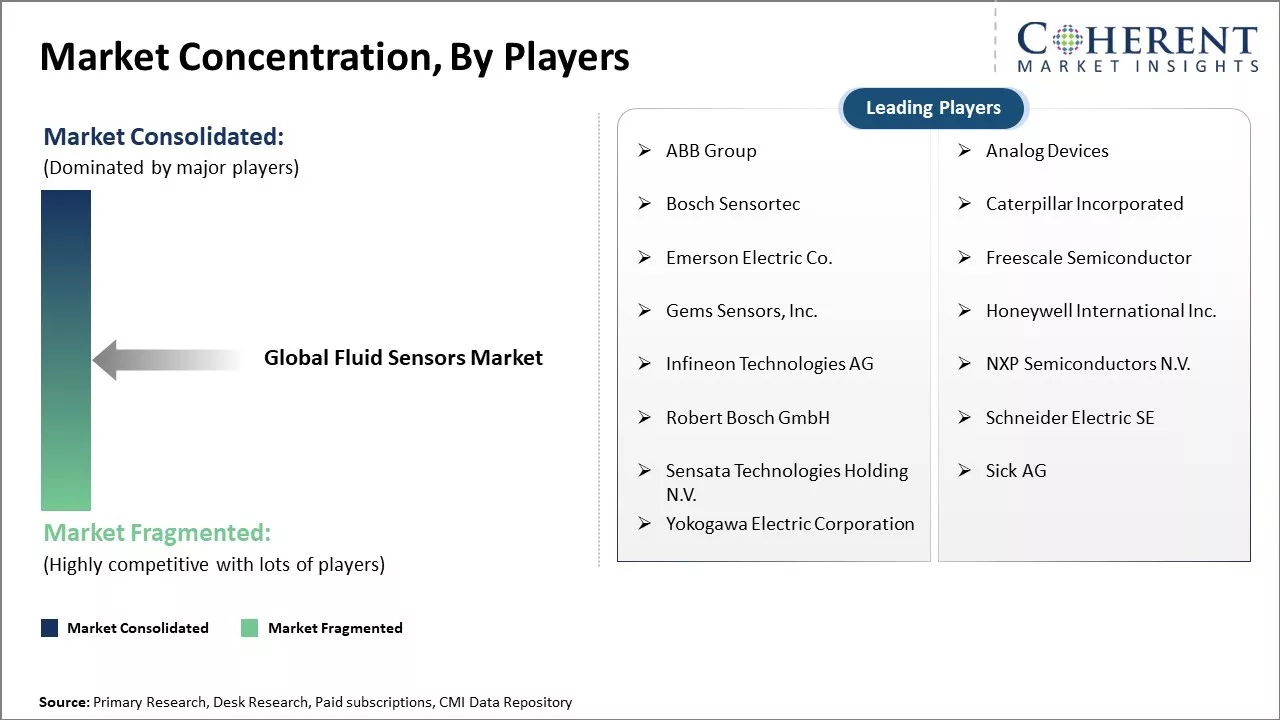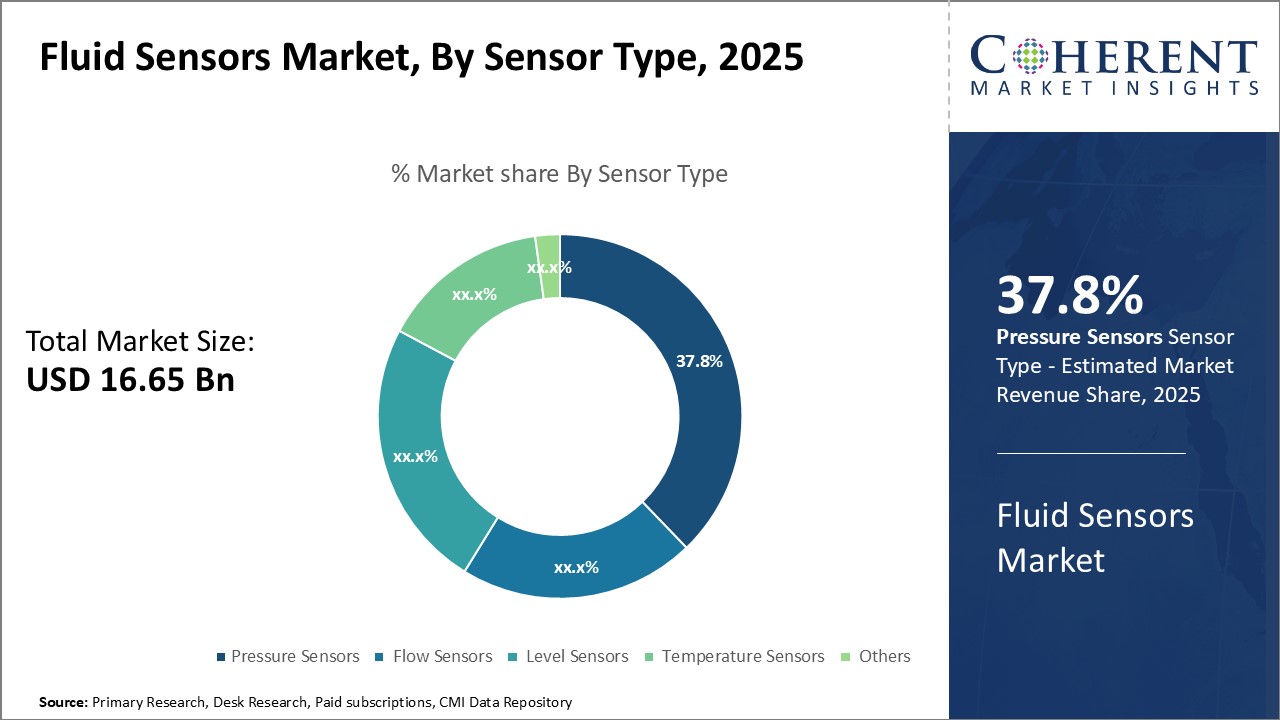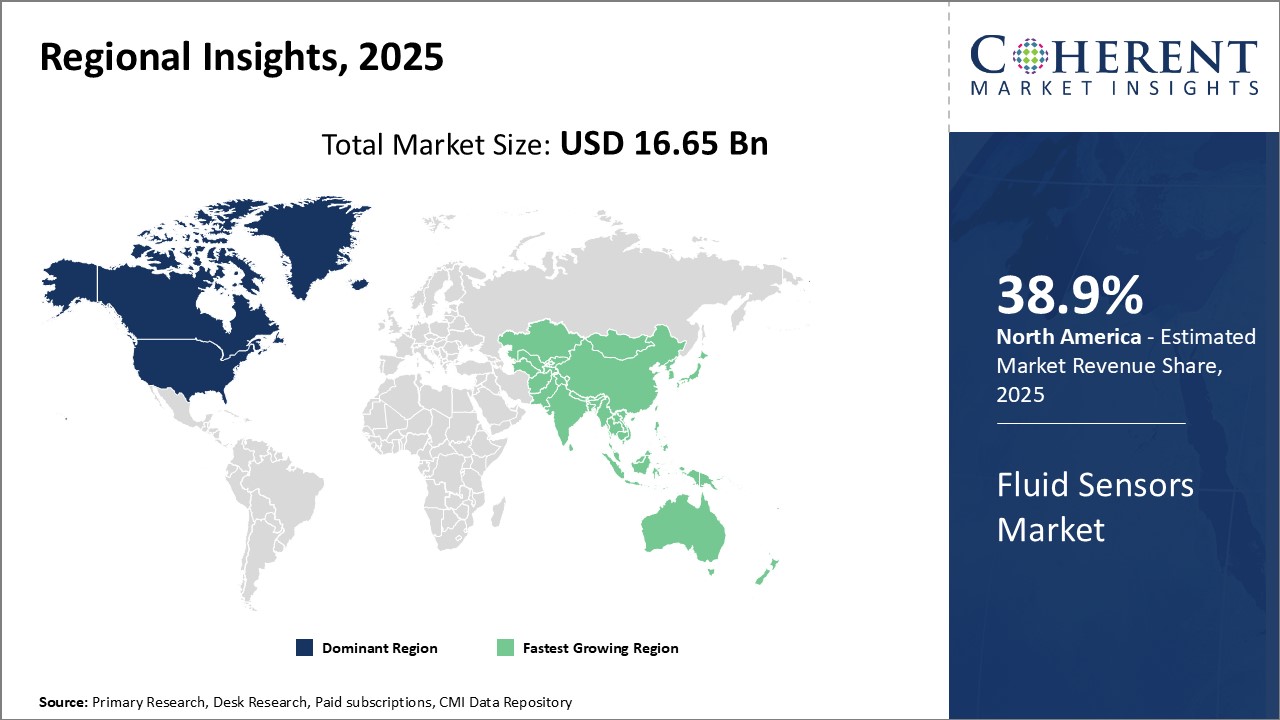Global fluid sensors market is estimated to be valued at US$ 16.65 Bn in 2025 and is expected to reach US$ 30.65 Bn by 2032, exhibiting a compound annual growth rate (CAGR) of 9.1% from 2025 to 2032.

Discover market dynamics shaping the industry: Request sample copy
Mass adoption across various end use industries such as automotive, manufacturing, food and beverages, oil and gas can drive the market growth. Fluid sensors are use in level, pressure and flow measurement solutions. Advancements in sensor technology boosts its usage.
Extensive R&D investments by major players for development of smart sensing technologies can offer new opportunities in the near future. Moreover, growing infrastructure development and construction activities across emerging countries of Asia Pacific and Middle East Africa can also boost demand. Strict regulations regarding safety and monitoring across industries can drive the fluid sensors market growth.
Growing industrial automation adoption
With advancement of industrial automation and adoption of Industry 4.0 technologies, there has been huge demand for fluid sensors across various industrial verticals. Manufacturing industries are increasingly automating their production processes and operations to gain efficiencies, reduce costs, and improve quality. Major industrial sectors like automotive, food & beverages, chemicals, oil & gas, power, and others are investing heavily in automation technologies like robotics, Internet of Things (IoT), artificial intelligence, and machine learning. This growth in industrial automation can offer opportunities for fluid sensors. Sensors that can detect and monitor fluid levels, pressure, viscosity, flow, and other parameters are critical components in modern automated machinery and systems. Fluid sensors help achieve precise process control and quality monitoring in applications such as injection molding machines, CNC machines, filling & packaging lines, and boilers & turbines among others. These play a vital role in condition monitoring and preventive maintenance of complex industrial assets. With growing focus on implementing smart factories and enhancing operational efficiencies through automation across diverse verticals, there has been huge demand for smart and connected fluid sensors.

Get actionable strategies to beat competition: Request sample copy
Increasing focus on safety and environmental regulations
Stringent regulations around workplace safety, hazardous material handling, and environmental emission norms across major economies can drive the global fluid sensors market growth. Governments and regulatory bodies are continuously tightening various guidelines to prevent accidents, protect workers, and curb pollution. For instance, laws mandating leak detection systems in oil & gas pipelines, storage tanks, and processing units are quite common. nowadays. Regulations on monitoring water quality levels, chemical leakage, and wastewater discharge parameters have also became rigorous globally. This growing emphasis on compliance propel end users to deploy advanced fluid sensing technologies for real-time monitoring applications. Automotive, aerospace, healthcare, and energy industries as well are adopting various fluid sensors to meet stringent production standards. Furthermore, rising environmental consciousness also compel manufacturers to minimize leaks, optimize resource usage, and reduce spills & wastage, thus, boosting e deployment of fluid sensors. Implementation of safety and emission regulations boosts demand for advanced sensor technologies that can help organizations achieve total regulatory compliance.
Key Takeaways from Analyst:
Global fluid sensors market growth is driven by increasing adoption of fluid sensors across various industries such as manufacturing, healthcare, oil & gas, and automotive. Strict regulations around fluid quality monitoring especially in the healthcare industry can also boost demand for these sensors. However, high initial costs of fluid sensors can hamper the market growth.
North America currently dominates the global fluid sensors market due to stringent quality control measures mandated across multiple sectors in the region. Asia Pacific is anticipated to emerge as the fastest growing market, owing to rising industrial automation and expanding manufacturing activity in China, India, and Southeast Asian countries. Growing investments in oil & gas exploration projects can also drive the fluid sensors market growth in Asia Pacific.
New product innovation and development of multi-parameter fluid sensors with advanced features can offer opportunity for manufacturers to expand their customer base. Increased shift towards smart factory automation also provides a window for incorporating more sensor-based monitoring systems. Adoption of Industry 4.0 standards that rely on real-time data collection for predictive maintenance offers growth opportunities. Collaboration with system integrators can help suppliers to capture the manifold opportunities arising from the evolution of Industry 4.0.
Market Challenges: Limited availability of reliable and accurate sensors for certain applications
Global fluid sensors market growth can be hampered by limited availability of reliable and accurate sensors for certain niche applications. While popular application areas such as automotive and industrial have a wide range of sensor options available, there still remain some application spaces that have highly specific requirements which are not fully addressed by current sensor technologies. Examples- marine applications needing sensors able to withstand severe underwater conditions or biomedical uses requiring biocompatible sensors capable of very precise and continuous readings. Device miniaturization additionally poses challenges as size reduction impacts reliability. Sensor producers need to focus more R&D efforts on developing new sensing mechanisms and materials capable of meeting the demanding technical criteria of these specialized use cases, in terms of parameters monitored, environmental resilience, lifespan and form factor. Standardization efforts may also help grow the available solutions by bringing application owners and sensor developers onto a common platform to jointly solve problems.
Market Opportunities: Development of miniaturized and wireless sensors
Global fluid sensors market presents a major opportunity in the development of miniaturized and wireless sensing solutions. The trend of IoT and industry 4.0 boosts demand for sensor technologies, which can be deployed in ever greater numbers across complex systems without compromising ease of installation or operating costs. Miniaturized sensors that are smaller, smarter and cheaper to produce than existing models open up new applications by enabling fluid monitoring within extremely space constrained environments or the sensing of micro-scale fluid phenomena. Wireless sensor networks eliminate the need for wires, which are expensive to install and maintain, especially over large areas, difficult to access locations or moving/rotating parts. These improve flexibility and ease of use. If sensor vendors invest in further advancing microfabrication and wireless communication methods, these can capitalize on the vast market potential of IoT-ready mini and wireless sensors across various industries that rely on distributed fluid monitoring like manufacturing, oil and gas, agriculture and infrastructure management.

Discover high revenue pocket segments and roadmap to it: Request sample copy
Insights By Sensor Type- Reliability and accuracy boosts demand for pressure sensors
In terms of sensor type, pressure sensors segment is expected to contribute the highest market share of 37.8% in 2025, owing to their ability to precisely and reliably monitor pressure levels across various industrial processes and equipment. Pressure is a critically important parameter that needs to be continuously tracked and regulated in multiple industries like oil & gas, healthcare, automotive, and others. Any fluctuations or issues related to pressure can potentially cause safety hazards, equipment damage, and business disruptions.
Pressure sensors efficiently fulfill the need for real-time pressure monitoring with high accuracy. Their robust designs makes them suitable for installation in harsh and demanding industrial environments.
Self-diagnostics and calibration features of modern pressure sensors further boost their adoption. These can precisely detect any sensor faults and calibration issues, reducing downtime for maintenance. Wireless connectivity options in new generation sensors provide remote monitoring convenience. Growing use of IoT and Industry 4.0 also boosts demand for integrated pressure sensing solutions. Their ability to stream pressure data in real-time for analysis and process optimization drives usage.
Insights By Fluid Type- Maximizing operational visibility and efficiency drives liquid fluid sensors segment
In terms of fluid type, liquid fluid sensors segment is expected to contribute the highest market share of 68% in 2025, owing to their widespread monitoring applicability across industries dealing with liquid handling and transportation processes. Precise monitoring and control of liquid levels, flows and quality parameters is crucial in sectors like chemicals, foods and beverages, oil and gas, pharmaceuticals and other.
Liquid flow sensors play a critical role in regulating liquid dosing and mixing operations. Their repeatable measurements ensure consistent product quality. Temperature sensors installed along with them compensate for fluid property variations caused by temperature changes. Level sensors securely avert overfilling of tanks and vessels by precisely tracking fluid levels in real-time. This positively impacts safety, reduces spillage and wastage.
This helps detect contaminations, optimize recipes and gain control over batch-to-batch variability. Furthermore, wireless and remote capabilities in modern liquid sensors provide convenient 24/7 condition monitoring without requiring physical interventions. Integrated flow computers accurately totalize flows for custody transfer applications.
Liquid fluid sensors deliver maximum operational visibility, safety and efficiency. Their dynamic measurements allow remote facility management and data-driven optimization of production workflows. This makes them highly useful across liquid-oriented industries.
Insights By End-use Industry- Stringent regulations and safety needs fuel adoption in oil & gas industry
In terms of end-use industry, oil &gas segment is expected to contribute the highest market share of 35.4% in 2025, due to strong compliance needs. Oil and gas operations like exploration, drilling, refining, storage and distribution involve complex infrastructure and hazards. Even minor non-conformities can potentially trigger disasters due to flammable nature of hydrocarbons.
Across the value chain, crucial parameters like pressure, flow, level, temperature need continual monitoring to ensure compliance with stringent international safety standards. For example, sensors guarantee pipeline pressure is safely managed per regulations. Offshore rig and facility sensors keep constant check on levels and flows to avert possible leakages into the ecosystem. Refineries largely rely on analytical sensors to timely detect contaminations in fuels and detect deviations from quality norms.
Sensors help optimize energy usage and throughput for operators. Continuous remote access to real-time sensor data further aids in predictive maintenance of assets. These also help optimize field performance through analytical insights. Considering massive investments made, even minor improvements scale up to large returns. Dynamics of oil & gas combined with regulatory oversight structures makes fluid sensors an indispensable part of safety and optimization needs for this sector.

Need a Different Region or Segment? Customize now
North America dominates the global fluid sensors market with an estimated market share of 38.9% in 2025. The strong presence of leading sensor manufacturers along with robust automotive and process industries drives the growth of the market in the region. The U.S. accounts for the largest share due to the high demand from various end-use industries. Leading automakers are focusing on manufacturing high-end and luxury vehicles with advanced safety and driver-assistance features that incorporate numerous fluid sensors. This boosts demand from the automotive industry.
In the process industry, stringent environmental and safety regulations mandate the use of fluid level and quality monitoring systems across oil & gas, chemical, and power generation plants. Numerous fluid handling companies rely on advanced fluid sensors for critical operations. The pricing of fluid sensors in the region is relatively higher due to higher R&D investments by manufacturers to integrate latest technologies.
Asia Pacific region has emerged as the fastest growing market for fluid sensors. China holds a major share and is expected to witness strong growth due to its large manufacturing sector. Rapid industrialization and infrastructure development activities across Southeast Asian countries such as India, Indonesia, Malaysia, and Thailand are creating significant growth opportunities. Growth in the automotive production coupled with increasing focus on manufacturing sensors domestically drives the market growth.
Countries in Asia Pacific offer comparatively low-cost manufacturing environments that attract investments from global sensor giants for setting up production facilities. This helps drive the domestic availability of high-quality fluid sensors at competitive prices. Presence of major automakers with large production capacities also ensures steady demand from the automotive sector. Continuous governmental support towards development of sensor technologies supports the growth of fluid sensora market in Asia Pacific region.
Fluid Sensors Market Report Coverage
| Report Coverage | Details | ||
|---|---|---|---|
| Base Year: | 2024 | Market Size in 2025: | USD 16.65 Bn |
| Historical Data for: | 2020 To 2024 | Forecast Period: | 2025 To 2032 |
| Forecast Period 2025 to 2032 CAGR: | 9.1% | 2032 Value Projection: | USD 30.65 Bn |
| Geographies covered: |
|
||
| Segments covered: |
|
||
| Companies covered: |
ABB Group, Analog Devices, Bosch Sensortec, Caterpillar Incorporated, Emerson Electric Co., Freescale Semiconductor, Gems Sensors, Inc., Honeywell International Inc., Infineon Technologies AG, NXP Semiconductors N.V., Robert Bosch GmbH, Schneider Electric SE, Sensata Technologies Holding N.V., Sick AG, and Yokogawa Electric Corporation |
||
| Growth Drivers: |
|
||
| Restraints & Challenges: |
|
||
Uncover macros and micros vetted on 75+ parameters: Get instant access to report
*Definition: Global Fluid Sensors Market involves a variety of fluid level, temperature, pressure and flow sensors used across various industries globally. These fluid sensors are designed to accurately detect and measure fluid properties and dynamics in applications such as manufacturing, oil and gas, chemicals, energy and power, food and beverages, automotive, and others. They help optimize processes, assure safety, monitor equipment health, and enable remote supervision and control in industries that deal with fluids.
Share
Share
About Author
As an accomplished Senior Consultant with 7+ years of experience, Pooja Tayade has a proven track record in devising and implementing data and strategy consulting across various industries. She specializes in market research, competitive analysis, primary insights, and market estimation. She excels in strategic advisory, delivering data-driven insights to help clients navigate market complexities, optimize entry strategies, and achieve sustainable growth.
Missing comfort of reading report in your local language? Find your preferred language :
Transform your Strategy with Exclusive Trending Reports :
Frequently Asked Questions
Joining thousands of companies around the world committed to making the Excellent Business Solutions.
View All Our Clients
US Reciprocal Tax Impact Analysis On Fluid Sensors Market
Stay updated on tariff changes with expert insights and timely information